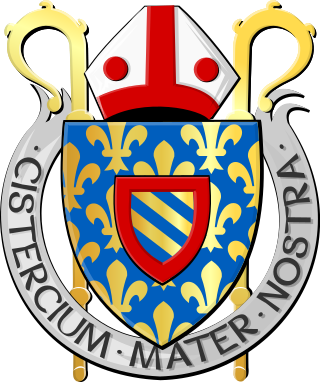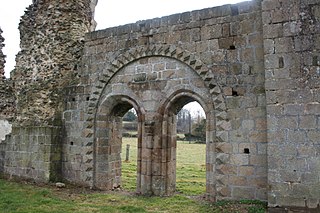
Bernard of Clairvaux, O.Cist., venerated as Saint Bernard, was an abbot, mystic, co-founder of the Knights Templar, and a major leader in the reform of the Benedictines through the nascent Cistercian Order.

Clairvaux Abbey was a Cistercian monastery in Ville-sous-la-Ferté, 15 kilometres (9.3 mi) from Bar-sur-Aube. The abbey was founded in 1115 by Bernard of Clairvaux. As a primary abbey, it was one of the most significant monasteries in the order. Dissolved during the French Revolution, it was used from 1808 to 2023 as Clairvaux Prison, a high-security correctional facility. As of 2024, work is in process to make the space available and attractive to tourists.

Cîteaux Abbey is a Catholic abbey located in Saint-Nicolas-lès-Cîteaux, south of Dijon, France. It is notable for being the original house of the Order of Cistercians. Today, it belongs to the Trappists.

The Cistercians, officially the Order of Cistercians, are a Catholic religious order of monks and nuns that branched off from the Benedictines and follow the Rule of Saint Benedict, as well as the contributions of the highly influential Bernard of Clairvaux, known as the Latin Rule. They are also known as Bernardines, after Saint Bernard, or as White Monks, in reference to the colour of their cowl, as opposed to the black cowl worn by Benedictines.

Cistercian architecture is a style of architecture associated with the churches, monasteries and abbeys of the Roman Catholic Cistercian Order. It was heavily influenced by Bernard of Clairvaux, who believed that churches should avoid superfluous ornamentation so as not to distract from prayer. Although a few images of religious subjects were allowed, such as the crucifix, elaborate figures common in medieval churches were prohibited. Later abbeys were constructed in Renaissance and Baroque styles, which were more ornate by nature.

Pontigny Abbey, the church of which in recent decades has also been the cathedral of the Mission de France, otherwise the Territorial Prelature of Pontigny, was a Cistercian monastery located in Pontigny on the River Serein, in the present diocese of Sens and department of Yonne, Burgundy, France. Founded in 1114, it was the second of the four great daughter houses of Cîteaux Abbey. It was suppressed in 1791 in the French Revolution and destroyed except for the church. In 1843 it was re-founded as a community of the Fathers of St. Edmund. In 1909 it passed into private ownership. In 1941 it became the mother house of the Mission de France, a territorial prelature.

The Abbey of Fontenay is a former Cistercian abbey located in the commune of Marmagne, near Montbard, in the département of Côte-d'Or in France. It was founded by Saint Bernard of Clairvaux in 1118, and built in the Romanesque style. It is one of the oldest and most complete Cistercian abbeys in Europe, and became a UNESCO World Heritage Site in 1981. Of the original complex comprising church, dormitory, cloister, chapter house, caldarium, refectory, dovecote and forge, all remain intact except the refectory and are well maintained. The Abbey of Fontenay, along with other Cistercian abbeys, forms a connecting link between Romanesque and Gothic architecture.
Geoffrey of Clairvaux, or Geoffrey of Auxerre, was the secretary and biographer of Bernard of Clairvaux and later abbot of a number of monasteries in the Cistercian tradition.

Savigny Abbey was a monastery near the village of Savigny-le-Vieux (Manche), in northern France. It was founded early in the 12th century. Initially it was the central house of the Congregation of Savigny, who were Benedictines; by 1150 it was Cistercian.

Grandselve Abbey was a Cistercian monastery in south-west France, at Bouillac, Tarn-et-Garonne. It was one of the most important Cistercian abbeys in the south of France.
Gerald of Sales was a French monastic reformer from Salles, Lot-et-Garonne near Bergerac, Dordogne in the south-west of France. His feast day is on April 20.

Hugh of Noara or of Novara, also known as Ugo of Novara and Hugo of Novara, was a Cistercian monk and a disciple of Bernard of Clairvaux. French by birth, he served as the first abbot of Novara Abbey, Sicily, where he remained until his death in 1170.

Barthélemy de Jur was a French bishop. He was bishop of Laon from 1113 to 1151. Some documents give his name as Barthélemy de Grandson or de Joux.

Vauclair Abbey otherwise Vauclerc Abbey was a Cistercian monastery founded in 1134 by Saint Bernard of Clairvaux at the request of Barthélemy de Jur, bishop of Laon. It was located in what is now the commune of Bouconville-Vauclair, department of Aisne, France.

Cambron Abbey was a Cistercian abbey in Cambron-Casteau, in the municipality of Brugelette, Hainaut, Belgium. It was located on the river Blanche, a tributary of the Dender, about 9 km (5.6 mi) to the south-east of Ath. Dissolved in 1782, parts of the abbey still survive as ruins within Pairi Daiza zoo and botanical garden.

Igny Abbey or Val d'Igny Abbey is a Cistercian abbey located in Arcis-le-Ponsart, Marne, France. It was founded in 1128 for Cistercian monks, dissolved in 1791 during the French Revolution, re-established in 1876 for Trappist monks, destroyed in 1918, reopened in 1929 for Trappist nuns and modernised in 2008–12 to accommodate three or four pre-existing communities.
Nicholas of Clairvaux, also Nicholas of Montiéramey was a French Benedictine monk who later became a Cistercian monk. He was a secretary of Saint Bernard of Clairvaux, and the author of letters and sermons.

Conrad of Bavaria was a Cistercian monk, the son of Henry the Black, Duke of Bavaria and Wulfhilde Billung of Saxony. The former Molfetta Cathedral, now renamed church of Saint Conrad of Bavaria, is dedicated to him, and he is also the patron saint of Molfetta, although formally speaking he was beatified rather than canonised.

Buzay Abbey, dedicated to Our Lady, was a Cistercian Abbey at Rouans in Pays de la Loire, France, formerly in Brittany, founded in 1135 and dissolved in 1790.
















